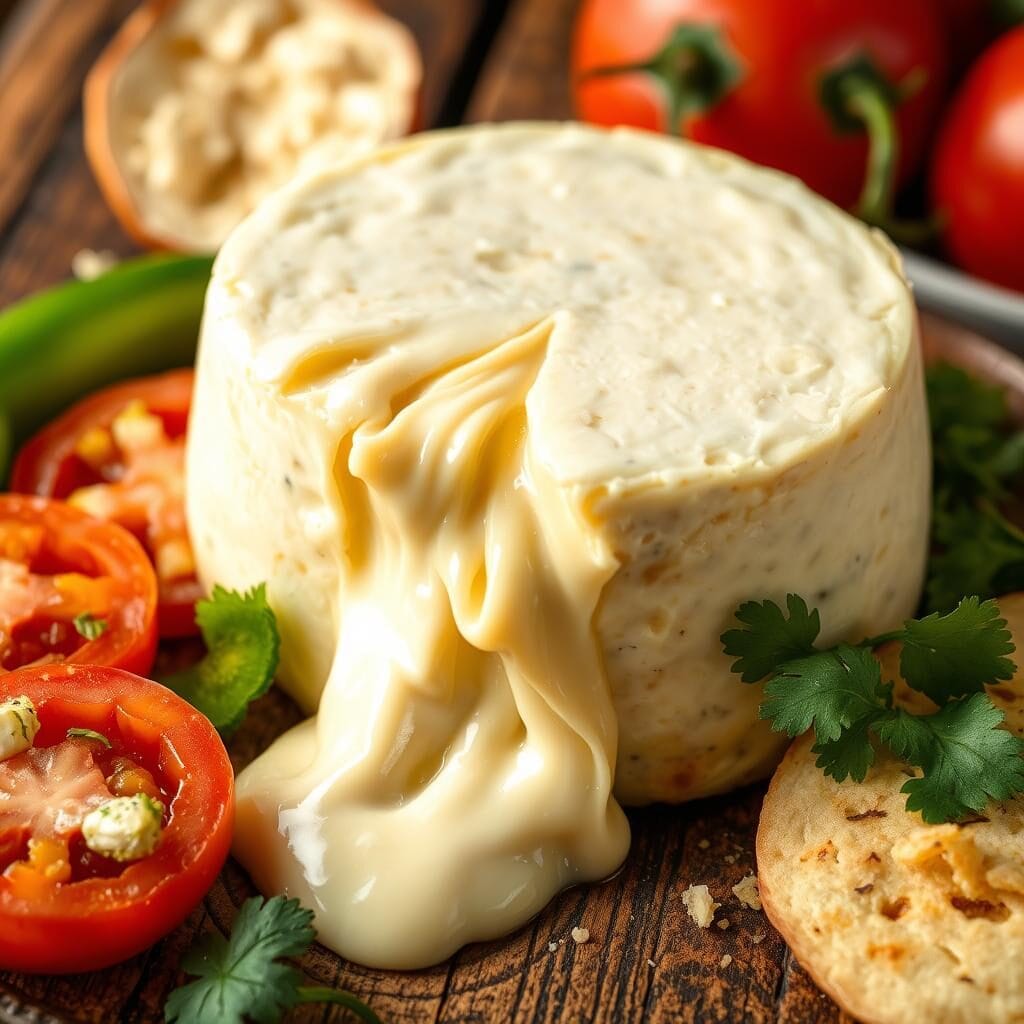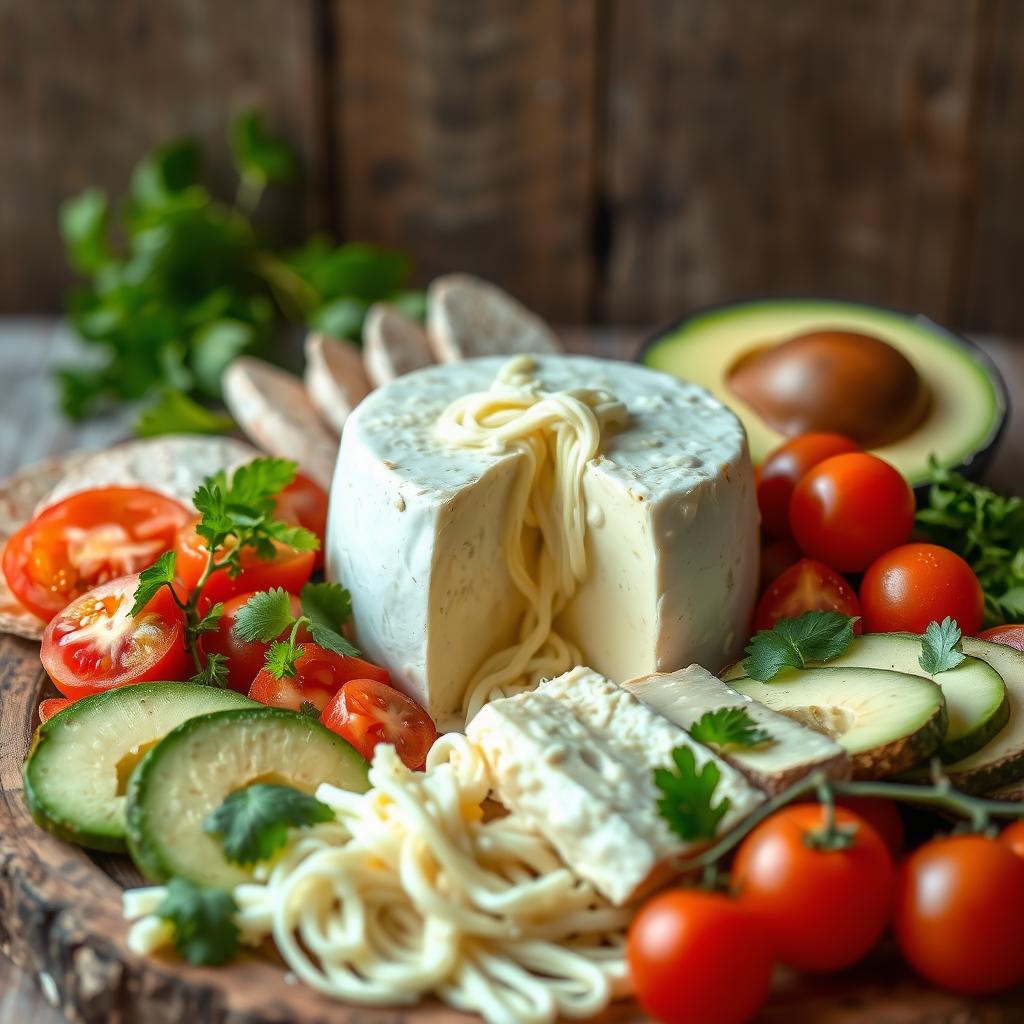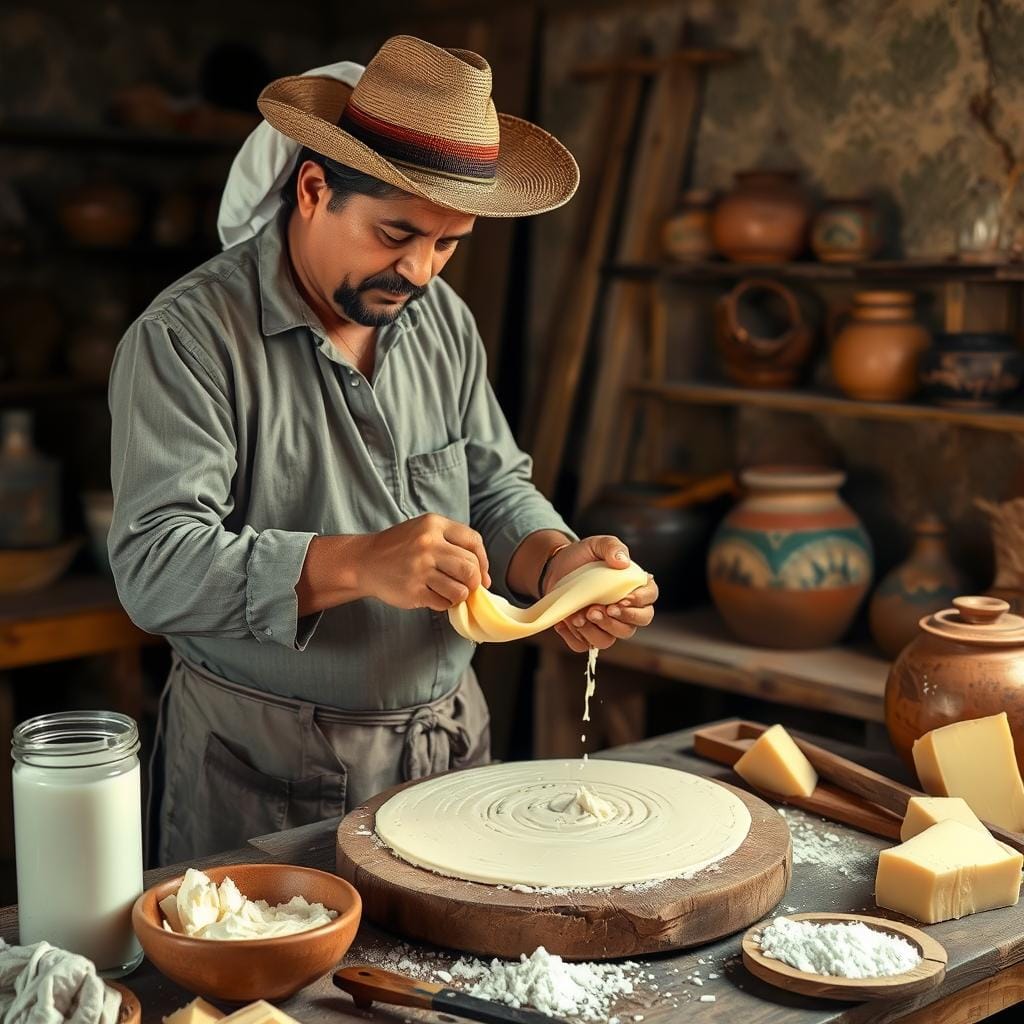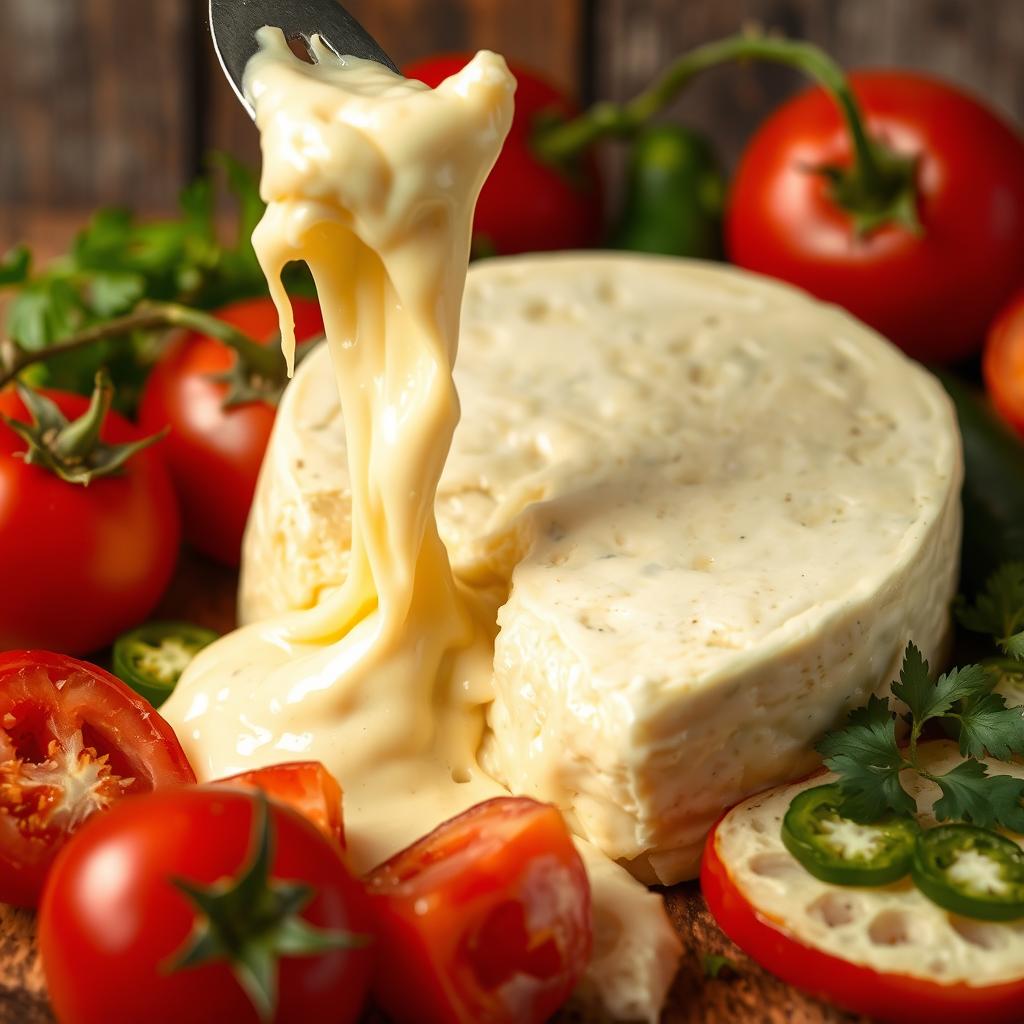What is the meaning of quesillo? It’s a beloved Mexican cheese known for its stringy texture and melt-in-your-mouth quality. I’ve always enjoyed exploring foods from around the world, but nothing intrigued me like quesillo. Not only is it incredibly delicious, but it’s also deeply connected to Mexican culture.
This guide will take you on a journey to learn about quesillo. We’ll explore its history, how it’s made, and its many uses in Mexican cooking. You’ll see how this cheese has become a key part of Mexican food culture.

Key Takeaways
- Quesillo is a traditional Mexican cheese known for its stringy, melt-in-your-mouth texture.
- It holds a profound cultural significance in Mexican cuisine, with a rich history and diverse regional variations.
- The traditional production process of quesillo cheese involves a unique stretching and kneading technique.
- Quesillo is widely used in various Mexican dishes, showcasing its versatility in the kitchen.
- Quesillo offers nutritional benefits, making it a healthier cheese option for your culinary adventures.
What Is The Meaning of Quesillo?
Quesillo, also known as Oaxacan cheese or queso Oaxaca, is a special Mexican cheese. It has a unique history. The name “quesillo” comes from the Spanish word “queso,” meaning cheese. It describes the cheese’s string-like texture and look.
Origins of the Name Quesillo
The name “quesillo” started in Mexico’s colonial period. Spanish settlers brought cheesemaking to the area. The name likely came from wanting to call this cheese different from others, like Oaxacan cheese.
Cultural Significance in Mexican Cuisine
Quesillo is key in Mexican food, especially in Oaxaca. It’s used in many traditional dishes. Its ability to melt makes it great for things like quesadillas, tacos, and enchiladas.
Regional Variations and Terms
Quesillo is also known as “queso Oaxaca” or “queso Asadero” in different places. These names show local traditions and how the cheese is made. But they all have the same string-like texture that makes quesillo special.

The Traditional Production Process of Quesillo Cheese
Making the famous quesillo cheese is a cherished tradition in Mexico. It’s a skill passed down through generations. This keeps quesillo a favorite in Mexican food.
The journey of quesillo cheese starts with picking the best milk. This milk often comes from local farms. The milk is then warmed and turned into curds.
This step is key for the stretching technique that makes quesillo special. It’s what gives the cheese its unique texture.
After the curds form, the cheesemaker stretches and kneads them. This creates the long, thin strings that are quesillo. This process not only shapes the cheese but also makes it elastic and chewy.

The last step is shaping and cooling the quesillo. This ensures it keeps its perfect texture and taste. Each batch of quesillo cheese is carefully made to be creamy and stretchy. This makes it great for many Mexican dishes.
From choosing the best milk to mastering the stretching, making quesillo cheese shows Mexico’s rich food traditions. It’s what makes Mexican cuisine so special.
Physical Characteristics and Texture of Quesillo
Quesillo, the beloved Mexican cheese, has unique physical properties. It has a stringy cheese-like texture, captivating color, and melts in your mouth. This artisanal cheese is a true culinary gem.
String Cheese-Like Properties
Quesillo’s most distinctive feature is its stringy cheese-like texture. When pulled apart, it forms long, delicate strands. This is due to the traditional production process, which involves stretching and kneading the cheese curd.
Color and Appearance
Quesillo has a pale, creamy hue that ranges from ivory to golden. Its appearance is smooth and glossy, with a semi-firm, pliable consistency. This makes quesillo visually appealing in many Mexican dishes.
Texture When Melted
When heated, quesillo transforms. It becomes creamy and stringy, retaining its strands while becoming smooth. This quality makes it perfect for dishes like [churro cheesecake].
“The combination of quesillo’s stringy cheese-like texture and its ability to melt seamlessly is what makes it such a versatile and beloved ingredient in Mexican cuisine.”
Differences Between Quesillo and Oaxacan Cheese
Both quesillo and queso Oaxaca are loved in Mexican cuisine. Yet, they have clear differences. Knowing these can help you enjoy authentic Mexican food more.
Quesillo is a string cheese made by stretching curds. This gives it a unique stringy texture. On the other hand, queso Oaxaca is semi-soft and braided, making it less fibrous.
| Characteristic | Quesillo | Queso Oaxaca |
|---|---|---|
| Production Process | Stretched and twisted curds | Braided curds |
| Texture | Stringy and fibrous | Semi-soft and compact |
| Origin | Oaxaca region | Oaxaca region |
| Melting Behavior | Melts well, maintains its stringy texture | Melts smoothly, loses its braided appearance |
Both cheeses hold a special place in Mexican culture. They’re often used in the same recipes. But, their unique qualities can change how a dish tastes and feels.
“The nuances between these two cheeses may seem subtle, but they can make a significant difference in the overall culinary experience.”
Knowing the differences between quesillo and queso Oaxaca helps in cooking and enjoying Mexican dishes. Whether you like the stringy quesillo or the smooth queso Oaxaca, these cheeses are key in Mexican food.
Common Uses of Quesillo in Mexican Dishes
Quesillo, the soft and stringy Mexican cheese, is a versatile ingredient. It shines in many traditional dishes. Its unique melting properties make it a staple in Mexico.
Popular Recipes
Quesillo is the star in classic Mexican dishes like quesadillas. Its stretchy texture creates the perfect cheese pull. It also adds creaminess to tlayudas, the oversized crispy tortillas.
Quesillo is also key in savory empanadas. It brings rich flavor and molten texture to these portable pastries.
Cooking Techniques
- Grate or shred quesillo to achieve the desired texture in your dishes.
- Slice quesillo into thin strips for a more uniform melt in recipes like quesadillas.
- Cube quesillo to create pockets of melted cheese in dishes like tlayudas or empanadas.
Best Melting Methods
To make the most of quesillo’s melting properties, try these techniques:
- Sauté or griddle quesillo briefly to achieve a delightful, gooey melt.
- Bake dishes with quesillo at moderate temperatures to slowly melt the cheese without overcooking.
- Add quesillo towards the end of cooking to preserve its texture and prevent it from becoming stringy or tough.
By mastering the art of cooking with quesillo, you can unlock a world of flavors and textures in your Mexican culinary creations.
Nutritional Value and Health Benefits
Quesillo, the beloved Mexican cheese, is packed with nutritional value and health benefits. It’s a quesillo nutrition powerhouse, great for a balanced diet. With lots of protein, quesillo is an excellent source of amino acids. These support muscle growth and body functions.
Quesillo also has a lot of calcium, which is good for bones and teeth. Its fat is mostly unsaturated, which is better for your heart than other dairy fats.
| Nutrient | Amount per 1 ounce (28g) of Quesillo |
|---|---|
| Calories | 122 |
| Protein | 9g |
| Fat | 9g |
| Carbohydrates | 0g |
| Calcium | 206mg |
Adding quesillo to a balanced diet can bring many health benefits. It’s rich in protein and calcium, supporting bone health and muscle growth. Remember, moderation is important, but quesillo can be a tasty and healthy part of your meals.
“Quesillo is a fantastic source of protein and calcium, making it a nutritious choice for those looking to support their overall health and wellbeing.”
Storing and Preserving Your Quesillo
Keeping your quesillo fresh is key. This Mexican cheese is loved for its taste and texture. Knowing how to store it right can make it last longer.
Proper Storage Methods
Temperature and humidity control are crucial for keeping quesillo fresh. Here are some tips to help:
- Refrigerate quesillo: Store it in the coldest part of the fridge, between 40°F and 45°F (4°C and 7°C).
- Wrap it tightly: Use plastic wrap or an airtight container to keep it moist.
- Avoid moisture: Keep it away from moisture to prevent mold.
- Consider freezing: For longer storage, freeze it. Wrap it in plastic or use a freezer-safe bag.
Shelf Life Guidelines
Proper storage can make your quesillo last longer. But, always check its condition:
| Storage Condition | Shelf Life |
|---|---|
| Refrigerated | 3-4 weeks |
| Frozen | 6-8 months |
Before using, always check your quesillo. Look for any signs of mold, bad smell, or color change. These mean it’s gone bad and should be thrown away.
By following these tips for storing quesillo and preserving Mexican cheese, you can enjoy its unique taste and texture for longer.
Where to Buy Authentic Quesillo
If you want to try the real taste of Mexican food, you need quesillo. This string cheese is a must-have for many traditional dishes. We’ll show you where to find top-notch, genuine quesillo in the United States.
Start by checking out Hispanic or Latin American grocery stores. These places usually have a big selection of Mexican cheeses, including quesillo. Make sure the label says “quesillo” or “queso quesillo” to get the authentic cheese.
If you can’t find a Latin American market, try specialty cheese shops or gourmet food stores. These places often have unique cheeses like authentic Mexican cheese quesillo. Ask the staff for help finding the best quesillo.
Can’t find quesillo in stores? The internet can help. Online stores that focus on Mexican or Latin American ingredients often have a wide range of buy quesillo products. Just make sure to check the vendor’s reputation and read customer reviews.
“Quesillo is the essential ingredient for so many traditional Mexican dishes, from enchiladas to quesadillas. Finding the right source for this authentic cheese can truly elevate your culinary experience.”
By using these tips, you can find the perfect authentic Mexican cheese – quesillo. Start experimenting with it and enjoy the flavors of Mexico in your kitchen.
How to Substitute Quesillo in Recipes
Looking for a quesillo substitute? There are many Mexican cheese options that work well. By knowing quesillo’s unique traits, you can tweak recipes to get similar tastes and textures. This way, your dishes stay true to their Mexican roots.
Best Alternative Cheeses
Here are some cheeses that are similar to quesillo:
- Oaxaca cheese: This stringy, semi-soft Mexican cheese melts well, making it a great substitute.
- Mozzarella: Not from Mexico, but its stretchy, melty texture makes it a good choice for quesillo.
- Queso fresco: A fresh, crumbly Mexican cheese with a flavor close to quesillo, though it melts less.
Adjusting Recipes When Substituting
Substituting quesillo might require some tweaks:
- Adjust the quantity: Quesillo and its substitutes have different moisture and fat levels. You might need to use a bit more or less to get the right texture and taste.
- Consider melting properties: Some cheeses, like queso fresco, melt differently. You might need to adjust cooking times or methods to get the cheese to melt right.
- Experiment with blends: Mixing two or more Mexican cheese substitutes can help you get closer to quesillo’s flavor and texture.
By trying out these quesillo substitutes and making small recipe changes, you can enjoy the unique taste of quesillo-based dishes. Even when you can’t find the traditional cheese.
Conclusion
Quesillo is a remarkable Mexican cheese with a special place in the country’s food culture. It has a unique origin and is used in many favorite dishes. This string-like cheese has won the hearts and taste buds of many Mexicans.
In this guide, you’ve learned about quesillo’s history and cultural importance. You’ve also seen how it’s made and its special qualities. Whether in a taco or on vegetables, quesillo shows the richness of Mexican food.
Keep exploring the quesillo cheese guide and the world of Mexican cheese overview. Embrace the flavors, textures, and traditions of quesillo. With a new love for quesillo, you can bring a bit of Mexico into your kitchen. Share the joy of this unique cheese with your loved ones.

